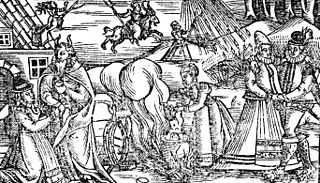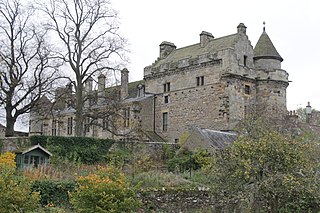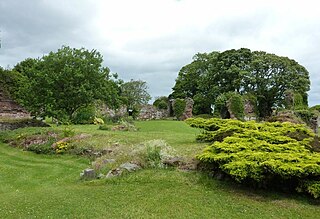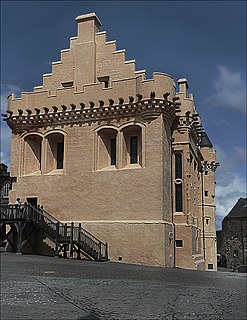Related Research Articles

Isobel Gowdie was a Scottish woman who confessed to witchcraft at Auldearn near Nairn during 1662. Scant information is available about her age or life and, although she was probably executed in line with the usual practice, it is uncertain whether this was the case or if she was allowed to return to the obscurity of her former life as a cottar’s wife. Her detailed testimony, apparently achieved without the use of violent torture, provides one of the most comprehensive insights into European witchcraft folklore at the end of the era of witch-hunts.

The ruins of Linlithgow Palace are situated in the town of Linlithgow, West Lothian, Scotland, 15 miles (24 km) west of Edinburgh. The palace was one of the principal residences of the monarchs of Scotland in the 15th and 16th centuries. Although maintained after Scotland's monarchs left for England in 1603, the palace was little used, and was burned out in 1746. It is now a visitor attraction in the care of Historic Environment Scotland.

Falkland Palace, in Falkland, Fife, Scotland, is a royal palace of the Scottish Kings. It was one of the favourite places of Mary, Queen of Scots, providing an escape from political and religious turmoil. Today it is under the stewardship of Ninian Stuart, who delegates most of his duties to The National Trust for Scotland. The Chapel Royal in the Palace is dedicated to Thomas the Apostle, and is also open to the public and reserved for Catholic worship.
The Treasurer was a senior post in the pre-Union government of Scotland, the Privy Council of Scotland.

Lindores Abbey was a Tironensian abbey on the outskirts of Newburgh in Fife, Scotland. Now a reduced ruin, it lies on the southern banks of the River Tay, about 1-mile (1.6 km) north of the village of Lindores and is a scheduled ancient monument.

Edward Bruce, 1st Lord Kinloss PC was a Scottish lawyer and judge.
The Octavians were a financial commission of eight in the government of Scotland first appointed by James VI on 9 January 1596.
John Tennent or Tennand of Listonshiels was a servant and companion of King James V of Scotland. He kept an account of the king's daily expenses which is an important source document for the Scottish royal court.
Sir Richard Cockburn of Clerkington, Lord Clerkintoun (1565–1627) was a senior government official in Scotland serving as Lord Privy Seal of Scotland during the reign of James VI.

Witchcraft in Orkney possibly has its roots in the settlement of Norsemen on the archipelago from the eighth century onwards. Until the early modern period magical powers were accepted as part of the general lifestyle, but witch-hunts began on the mainland of Scotland in about 1550, and the Scottish Witchcraft Act of 1563 made witchcraft or consultation with witches a crime punishable by death. One of the first Orcadians tried and executed for witchcraft was Allison Balfour, in 1594. Balfour, her elderly husband and two young children, were subjected to severe torture for two days to elicit a confession from her.
Thomas Foulis was a Scottish goldsmith, mine entrepreneur, and royal financier.
George Young was a Scottish churchman, courtier, member of the Privy Council of Scotland, diplomat, and secretary depute.
Robert Jousie or Joussie or Jowsie or Jossie was a Scottish merchant, financier, and courtier.
Julian Goodare is a professor of history at University of Edinburgh.
Wilhelm von der Wense was a German courtier and Danish diplomat.

Queen Elizabeth I of England paid a subsidy to King James VI of Scotland from 1586 to 1602.

Jerome Bowie was a servant of James VI of Scotland.
Alexander Hay of Easter Kennet was a Scottish lawyer and politician.

Some of the remaining and ruined Scottish royal palaces have kitchens, and the halls or chambers where food was served, and rooms where food and tableware were stored. There is an extensive archival record of the 16th-century royal kitchen in the series of households accounts in the National Records of Scotland, known as the Liber Emptorum, the Liber Domicilii and the Despences de la Maison Royale, which are daily records of the purchase of food and drink. The royal kitchens in the 1530s employed around 60 people. Supplies of food for the royal household were known as "furnishing" and were usually managed by the Masters of the Household. Charles II came to Scotland in 1650 and a new Scottish household was created for him, and an account of food and spices survives for his stay at Falkland, Stirling, and Perth, where he may have stayed in the old Gowrie House.
Violet Mar was a Scottish woman accused of plotting the death of Regent Morton by witchcraft.
References
- ↑ 'Obituary: Dr Athol Murray, historian, scholar and former Keeper of the Records of Scotland', The Scotsman, 20 August 2018
- ↑ 'Obituary: Dr Athol Murray, historian, scholar and former Keeper of the Records of Scotland', The Scotsman, 20 August 2018
- ↑ Alan Borthwick, 'Athol Murray, 8 November 1930–24 August 2018: An Appreciation', SHR, 98:1 (April, 2019), pp. 128-30
- ↑ Julian Goodare, State and Society in Early Modern Scotland (Oxford, 1999), pp. 126-7 & fn. 86, citing Murray, 'Notes on the Treasury Administration', Treasurer's Accounts, vol. 12, pp. xxx-xxxi.